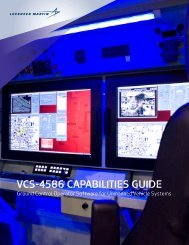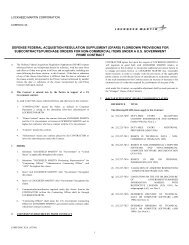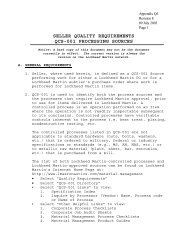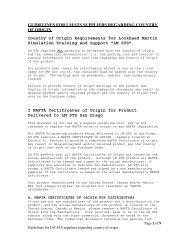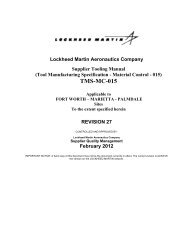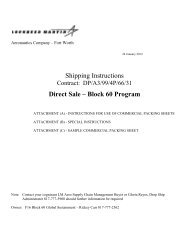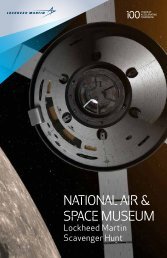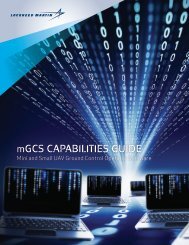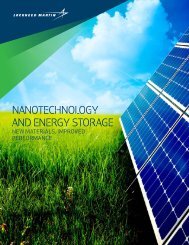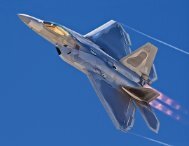Highlights - Lockheed Martin
Highlights - Lockheed Martin
Highlights - Lockheed Martin
- No tags were found...
Create successful ePaper yourself
Turn your PDF publications into a flip-book with our unique Google optimized e-Paper software.
MAPPING THE MOON. GRAIL is the first time two robotic spacecraft have been flown in the same precise orbit around a planetary bodyother than Earth. The gravitational map created by the GRAIL mission will improve our knowledge of the near side of the moon gravity by100 times and the far side by 1,000 times. This knowledge will enable scientists to understand the moon’s interior composition andstructure, which can lead to understanding its origin.Continued from page 11SSC’s Sensing & Exploration Systems (S&ES) line ofbusiness saw three launches in a four-month period. NASA’sMars Science Laboratory (MSL) was the third. Launchedon Nov. 26, 2011, it was successfully sent on its way toMars by a ULA Atlas V 541. The mission’s large Curiosityrover is encapsulated and protected in an aeroshell that wasdesigned and built by SSC. The rover, built by JPL, will seekto determine whether the Red Planet was, or still is, habitablefor microbial life. The nearly 15-foot-diameter aeroshell isa blunt-nosed cone that protects Curiosity from the intenseheat and friction that will be generated as the system descendsthrough the Martian atmosphere in early August 2012. <strong>Lockheed</strong><strong>Martin</strong> has designed and built every aeroshell flown byNASA to Mars dating back to the Viking landers.NASA selected three missions for Phase A studies forits next Discovery science mission. After detailed review in2012, NASA will select one to continue development andlaunch in 2016. SSC is the industry partner on all three potentialmissions. InSight would study the structure and compositionof the interior of Mars. TiME would land in – and floaton – a large methane-ethane sea on Saturn’s moon Titan.Comet Hopper would study cometary evolution by landingon a comet many times and observing its changes. Two ofthe missions would use the Advanced Stirling RadioisotopeGenerator (ASRG) to generate electricity. The ASRG isunder development at SSC’s Valley Forge, Pa. facility.The Mars Atmosphere and Volatile EvolutioN(MAVEN) mission reached a major milestone during thesummer when it successfully completed its Critical DesignReview (CDR). Led by the University of Colorado and managedby NASA’s Goddard Space Flight Center, MAVEN willbe the first mission devoted to understanding the Martianupper atmosphere. SSC is building the spacecraft and recentlycompleted the main spacecraft structure. The Martianorbiter is scheduled for launch in November 2013.In early 2011, the SSC team designing NASA andNOAA’s Geostationary Operational EnvironmentalSatellite R-series (GOES-R) weather satellite successfullycompleted its system Preliminary Design Review, a majormilestone in the program’s development. GOES-R is thenation’s next generation geostationary weather satellite andis scheduled for a 2015 launch.S&ES’s Coherent Technologies deployed its WindTracer ®Doppler Lidar systems to two airports in Germany in additionto Columbia Gorge, Oregon and New Jersey for windfarm site analysis.NASA announced missions selected for Phase A studiesfor its next Explorer program. SSC is on the team thatis proposing the Observatory for Heteroscale Magnetosphere-IonosphereCoupling (OHMIC) mission led by theSouthwest Research Institute. If chosen, OHMIC would usea pair of spacecraft, built by SSC, to study the processes thatprovide energy to power space weather storms. The AdvancedTechnology Center (ATC) would design the electronics forone of the cameras on OHMIC, and an ATC physicist willserve as co-investigator for the mission. Explorer missionwinners will be announced in early 2013.In addition, NASA announced Explorer technologydevelopment funding for the Exoplanetary CircumstellarEnvironments and Disk Explorer (EXCEDE) mission.SSC is on the EXCEDE team led by the University of Arizonathat is developing studies of the formation, evolution,and architectures of exoplanetary systems, and characterizingcircumstellar environments in habitable zones.12 13




